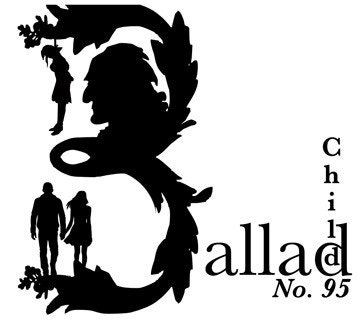THERE were two sisters, they went playing,
Refrain: With a hie downe downe a downe-a
To see their father’s ships come sayling in.
Refrain: With a hy downe downe a downe-a
And when they came unto the sea-brym,
The elder did push the younger in.
‘O sister, O sister, take me by the gowne,
And drawe me up upon the dry ground.’
‘O sister, O sister, that may not bee,
Till salt and oatmeale grow both of a tree.’
Somtymes she sanke, somtymes she swam,
Until she came unto the mill-dam.
The miller runne hastily downe the cliffe,
And up he betook her withouten her life.
What did he doe with her brest-bone?
He made him a violl to play thereupon.
What did he doe with her fingers so small?
He made him peggs to his violl withall.
What did he doe with her nose-ridge?
Unto his violl he made him a bridge.
What did he doe with her veynes so blew?
He made him strings to his violl thereto.
What did he doe with her eyes so bright?
Upon his violl he played at first sight.
What did he doe with her tongue so rough?
Unto the violl it spake enough.
What did he doe with her two shinnes?
Unto the violl they danc’d Moll Syms.
Then bespake the treble string,
‘O yonder is my father the king.’
Then bespake the second string,
‘O yonder sitts my mother the queen.’
And then bespake the strings all three,
‘O yonder is my sister that drowned mee.’
‘Now pay the miller for his payne,
And let him bee gone in the divel’s name.’
I've heard people claim America's culture is bland, without a long history, and commercial in nature. While there are reasons and points to the previous claim, to make a general statement with out investigation is in no ones interest on this subject. Modern migrations have brought old histories and culture to obscure the American "native" one and time has gone on to obscure our shared histories and amalgamated them to where we can't always decipher what came from where. Modern Philosophies and "Avant Garde" art don't spring spontaneously from the ether and its easiest to be shocked by the things we choose to self censor. Many of the contemporary art movements seek to distance themselves away from 1960's art history and the idea of the object and viewer in a private space. I believe this distancing is un-necessary as more community based projects and performance art began to grow then along with Folk Music making a revival into the popular scene (an unfinished thought). At UnionDocs on February 10th and 11th you will have the opportunity to experience, with others, documentery films about the sharing of songs and stories, experience the songs performed live and artistic interpretations of the Child Ballads through paintings on exhibition.
Hey! Stay on track already. . . So. . . Child Ballad no.10, known as "The Cruel Sister", and "Twa Sisters" is an old tune dating to the 1600's; a song over 400 years old and still sung today; the Twa Sister's has been covered by Paul Clayton and even as late as Tom Waits in a 2006 recording. If my memory serves me right, Art Rosenbaum, who worked with his son Neil on one of the documentaries being screened at UnionDocs, recorded Mary Lomax singing this song or part of it. Whats important about Mary singing this song is that the song was passed to her by her father in a long line of oral tradition at which roots go back to the 1600's. Even though the Child Ballads are not totally inclusive of every single ballad, they represent a hefty cross section of what we may consider an American cultural equivalent to Beowolf or even Homer's poems. I'm sure if we dug deep enough both of those form an influence upon the ballads somewhere. The themes in the ballads are not necessarily restricted to Western, or European ideas and archetypes but can be found around the world in all cultures. The "Twa Sisters" design I developed is based on a variation where the sister that has been wronged has been made into a violin. When she is played before her parents, her sisters crime is found out. We always hope justice finds those who wrong. Unless sometimes its ourselves who are the cruel sister, perhaps then we wouldn't want "to face the music". Paying people there dues, many thanks to Teddy Johnson and Heather Fares who have done a tremendous amount of work preparing for the Child Ballad shows in both Baltimore and New York. They will be continuing to work together and are setting up a new exhibition for The Rotating History Project in Baltimore. . . --->http://rotatinghistory.blogspot.com/ .








